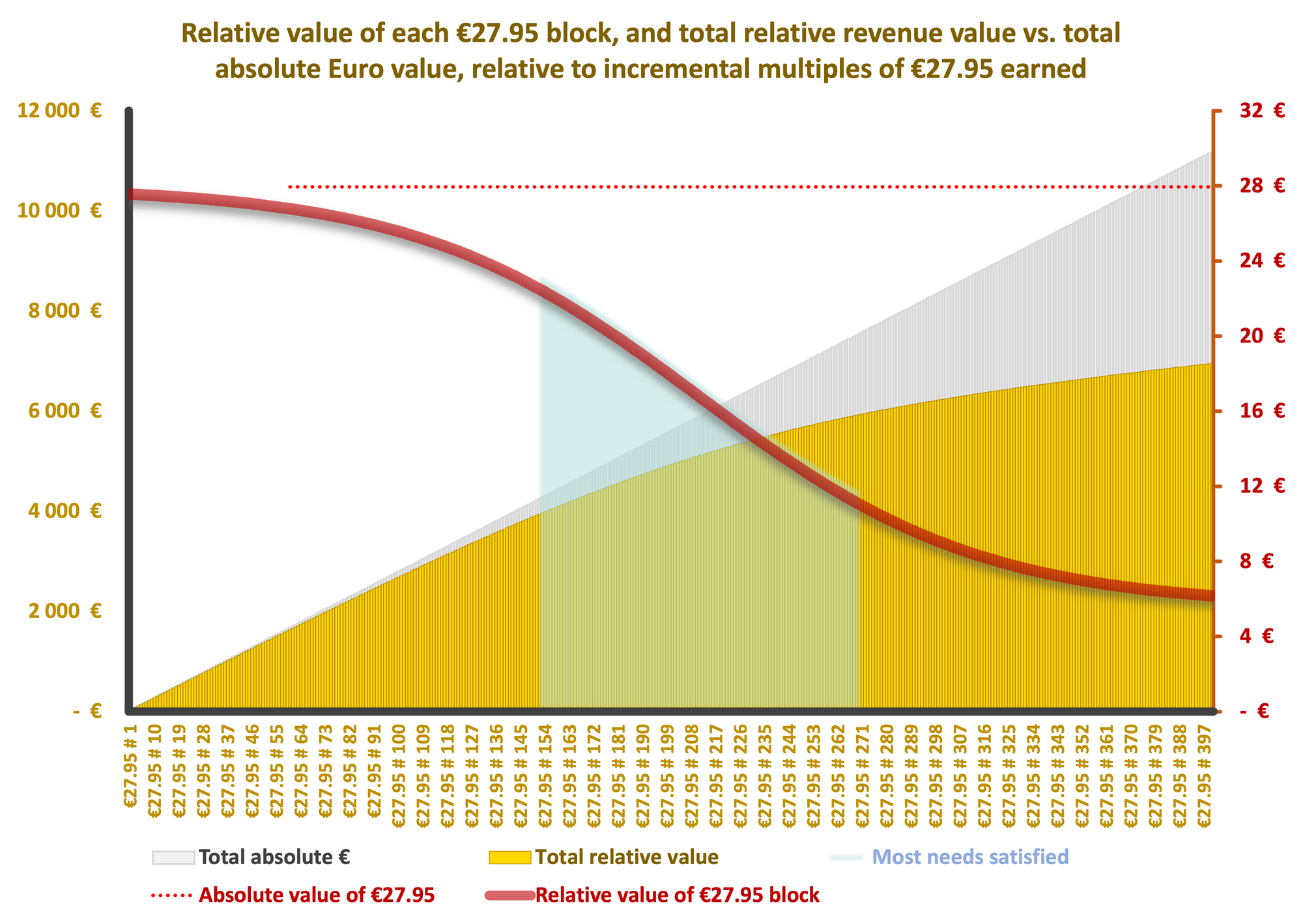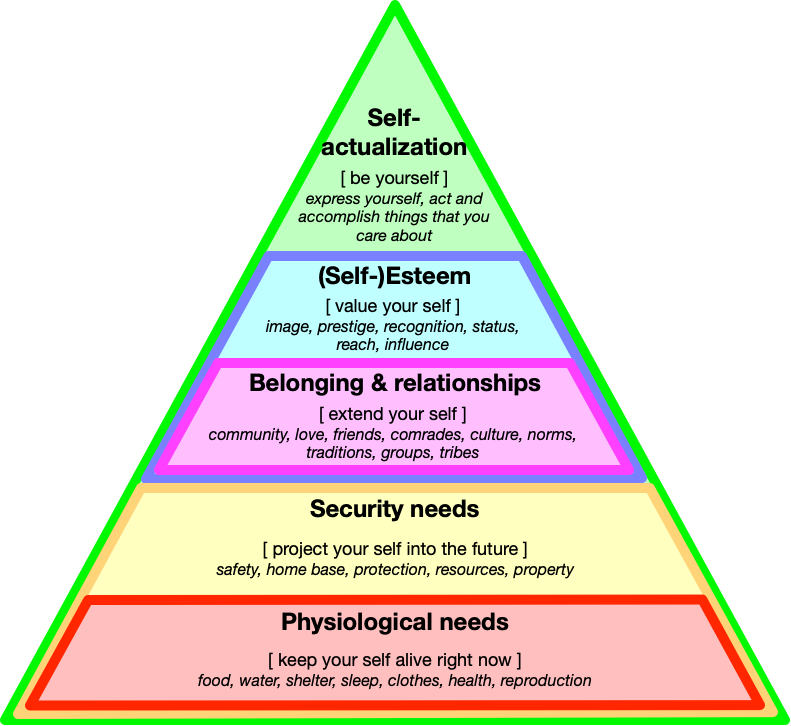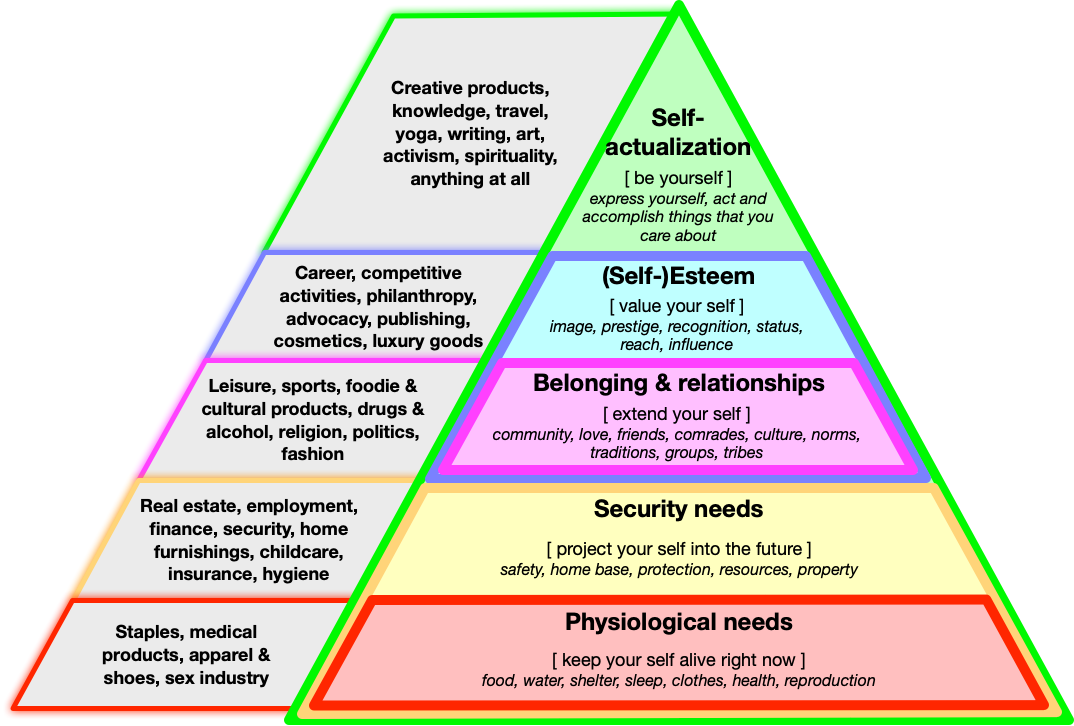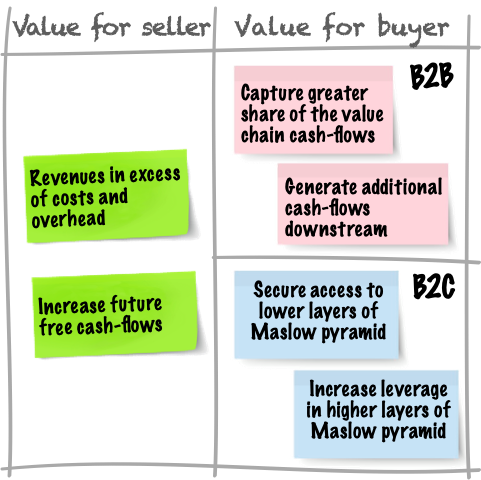What is the value of a product? | Creating and Measuring Value
What does it mean for a product to have Value? A product has a price, and there are plenty of methods to determine willingness to pay. How does that relate to how much Value a product creates? I continue my investigation of the concept of Value in this installment of the Measuring Value series.

In my previous post, I layed the basis of the discussion of what Value is understood to be. I took as the starting point the notion of Business Value, and explained two things:
- the four basic definitions of value in economic terms;
- the value chain.
But I'm sure it will be obvious to you that to ask "what is Value?" and then say that Value is the sum of cash flows captured throughout the value chain is kicking the can down the road: at the end of the chain, there's a customer who buys a finished product and uses it, period. It no longer gets transformed, packaged, resold and value-added to. It just meets a need that has no financial counterpart.
Aha: a use and a need, at last!
But to say that this need at the end of the chain has no financial counterpart can be confusing: that need has a price, which is the price of the thing that met the need and represents the consumer spend in the value chain diagrams.
So why don't we say that, if this need is fulfilled by an item that has a sales value of €27.95, then that's the value of that need?
The problem, and this is where the definition of value gets interesting and hazy, is that if that need is actually worth €27.95, then why would I spend €27.95 to satisfy it? I can just as well keep the €27.95 instead of fulfilling the need!
There's no benefit for me to spend the amount if that amount has the same value as the need. In order to do a deal, I need to get something out of it that I didn't have before.
That's the fundamental mystery of value accounting: if satisfying the need has the same value as the sales price of the thing that satisfies it, then satisfying the need or keeping the €27.95 makes no difference. In order for me to spend the €27.95, there needs to be value to me beyond that €27.95 in order to make the transaction worthwhile.
How much more? When do I know that shelling out €27.95 will bring me more value than the value that €27.95 has to me?
I just implied that €27.95 has a specific value to me in a unit that is not a currency unit. What is that unit?
Mmm. So if €27.95 has value to me in some other unit that I don't yet know, let's maybe first wonder this: where do I get that €27.95 from? I get it from the revenue that I collect from my work, don't I? And how do I know what it's worth to me relative to the need I want to fulfil?
OK. So let's try from that angle, to see if we can define that magical unit of Value using the decision that I make to perform some work in exchange for a relatively predictable and agreed amount of revenue. How does that work?
I have a need, and in order to satisfy it, I want to buy something that costs €27.95. So now I must generate some revenue.
The question is: How much revenue is enough such that €27.95 will be worth less than what satisfying that need is worth to me?
The amount of revenue that I need is the amount at which, considering all the other needs that I have and how much money they cost to satisfy, the relative value that I assign to €27.95 gets to be lower than the value that I assign to satisfying the need in question.
In other words, and this is the shocker here: there is a set value that I assign to satisfying that need – it's a fixed quantity, that is exclusively a function of how much I think I need it, irrespective of how much it costs.
The relative value, here, is how much I care about €27.95 relative to satisfying that need. The value that I assign to €27.95 is a function of the amount of currency units that I have to distribute between my needs. €27.95, although it's a precise number, is expressed in a unit of exchange (€) that in and of itself carries no value information. It's only by converting it to a percentage of my total available income and my already satisfied needs, that I can use it to assign a numerical value to things.

In other words, the relative value of the thing is the ratio of a percentage of my available income over the priority ranking of that need in my list of needs.
When I hear "priority ranking of needs", I think hierarchy of needs and Maslow's pyramid. OK, so far so good, makes sense.
Maslow's pyramid
Everybody knows what Maslow's pyramid is. Here's my version, how I understand it:

It's useful to note that, while each lower layer is required to be able to engage in the higher layer (i.e. if I want to be able to worry about having resources for tomorrow, I have to stay alive right now, if I want to have prestige, I need to belong to a community, and so on), it is also true, that each higher layer significantly improves your ability to manage the lower layer! Such that if I have a high status, then my belonging to a group is easier and more valuable, if I have a stable home and property, then it's much easier and more pleasurable for me to stay alive today, and so on. There is a typical accumulationist logic at work here.
Anyway, given this set of relatively well-established needs, what are the things in the market that correlate to this hierarchy of needs? I have attempted to map markets, industries and concrete activities to the various levels of the pyramid. Maybe you'll find that a little cynical, and might disagree on this particular cynical take, but there's no escaping cynicism when mapping market goods to fundamental human needs.

Now here's another mystery: given Maslow's pyramid, my need for food and water is far more important to me than the need for my status maintenance at the golf club, for example, or for my creative writing course. Yet, these days the price of food and water is much lower than the price of things I might buy for status consolidation or creative activities. So the monetary value of something is definitely not related to how critical it is to your survival.
I remember reading that, a few decades ago, a typical westerner would spend 30% of their budget on food. Today, it's 10% or so. Does that mean that eating and drinking has become less of a need today than it was? Yes and no.
- No, in that people need to eat and will need to eat as long as there are people. The absolute ground-level need for eating is the same now as it always was and will be.
- On the other hand, yes, in that the supply of food has become so abundant and cheap nowadays, that, for a median western human, we don't expect go hungry. The ability to satisfy the hunger need has become so widespread that the relative portion of food in our budget is much lower than it was.
So we have to decide between the role that the absolute need plays in our value assignment, versus the relative availability of the goods and services required to satisfy that need, versus the price of that thing, versus the relative value of that price to my available funds, given my other needs.
In terms of how this absolute need is evaluated, let's remember that although lower layers are more necessary than higher layers, higher layers make it easier to fulfill lower layers. This is why the higher layers are ultimately more valuable: they have value in and of themselves, but they also make the value of the layers above and below more achievable. So the value of the lower layers is transferred, at least in part, to the higher layers, in the form of a protection against the lower layer needs.
For instance, esteem and belonging help me keep the basic pshysiological and safety needs at bay, because they mean that I have a network that secures both that I can procure resources, and that I have other things to worry about. Things that keep these basic needs fulfilled as a matter of course, rather than as a matter of concern, are more valuable than the immediate fulfillment of the lower needs.
At the end of the day, a key value criterion here is to reduce the percentage of my resources that I spend on lower needs, as this is a confirmation of how little I need to worry about them. It's a sort of paradox: the less of a fundamental need something is, the more valuable it is!
There are three aspects or properties at play here, however:
- One one hand, the reason it's more expensive is not because it has more intrinsic value, but rather because in order to access this higher layer of the pyramid, there needs to be disposable income that remains after the lower layers have already been fulfilled. Once the lower needs have been fulfilled, the relative value that I assign each €27.95 that remain in excess decreases. This would imply that the higher up we go, the value of things is more and more relative to the remaining budget that I have. In other words, they have little value, but the more buckets of €27.95 I have, the less valuable each bucket is to me. According to this logic, the more expensive something is, the less critical value it has.
- On the other hand, an intrinsic reason why items higher in the pyramid might be more expensive is that as we go up into the pyramid, personal needs will have much greater variation across the population. While everybody needs to eat food, the basic foods are made of various compositions of protein, fibre, fat, sugar, salt, acid and the like. However, as you go up to ego and self-actualization, the needs become more and more personalized. I may like to paint beautiful pictures using very specific techniques, you may prefer to excel at a particular sport that gives you a lot of pleasure, someone else might prefer to build toys for their grandkids or play videogames. These ego and self-actualization items are not common to all. We therefore assign them greater value because they are more representative of who we are, and this has a lot of value to us, to which we are happy to part with more units of availble income.
- Lastly, there is also the question of economies of scale and scope. Given that price is at least constrained by cost, the lower the cost at which I can produce something, the cheaper it can be, obviously. Yet, there is more incentive to lower the production costs of something when the market for it is extremely large and basic demand is guaranteed. Given that all humans need to eat, and as long as not all of them can meet that need, then developing cost-efficient food volume scaling techniques will be rewarded by the market, and there will be a lot of competition to produce for that need. In other words, humanity will always dedicate resources to produce food as cost-efficiently as possible. Whereas for more personal and discretionary needs, such as self-actualization and ego-driven needs, the demand is variable and is in fact driven much more directly by the price/value relationship.
OK, so we can't resolve all these drivers into one magic equation for value, at least I can't. But we've learned some things about what value is:
- The price of something is not the value that it has for the purchaser. In order for someone to do a deal, that deal has to generate value for them. This means that by purchasing something, I need to get more value from it than the value that I assign to everything I have to give up for it, which includes the price. This is a fundamental question of deal-making: a deal has to bring value to both parties. If at the end of the deal one of the parties is left with the same value as they had before the deal, then this is not a value-generating deal, so it won't be made.
- To the extent that value is measured by currency, we have seen that currency is not a linear unit. Currency only measures Value as a function of how much currency I have to distribute over my needs. The fact that some things are more expensive than others does not mean that they have more Value: it means that people who buy these things have more currency available to them, therefore currency has less value to them. The need to have a yacht is the same for all humans: it's fantastic to have one, the pleasure that we get from it is huge. I don't enjoy a yacht more if I'm a billionaire than if I earn minimum wage –arguably, I'd enjoy it more if I earned minimum wage. It's just that the relative value of €100M to a billionaire is far less than what it is for a minimum wage earner.
- The Value of something is not the same for all participants in the deal, it depends on what these participants are attempting to optimize for, which drives what measures they use to value things. It's a little bit of a tautological statement, but never mind. This asymetry is part of the reason why it's possible to create value in a deal, even though the seller receives the same amount of currency as the buyer spends, and yet each derives a different value from the deal.
So what is the value of a product?
To be honest, I'm not sure where I'll end up falling on this question once I finish this whole series, but at this point in my thinking, I like the following idea:

Value for the seller of a product represents primarily revenues in excess of costs, and the ability to increase and maintain cash-flows over time. That means for instance that in some cases, it's the product that creates the value, like in subscription businesses, in others, it's the ability to continuously output products, think Zara.
For your buyer, whether you're selling into a piece of the value chain or you're selling to the consumer, the value equation is completely different. In the B2B sector of the value chain, the value for your customer will consist in increasing their ability to capture a greater share of the profits, or to unlock new or incremental cash-flows downstream from them. For instance, if I produce a new material that increases durability, then this might make it worthwhile for my customer to create a new line of products. This will generate new cash flows to the value chain that my customer can retain, thus increasing their overall share. So in B2B, value always boils down to cash-flows.
If I'm selling to the consumer on the other hand, then the value for them is not in terms of cash-flows. What will matter to the consumer is whether this product helps them edge up the Maslow pyramid layers. Either by securing the lower layers to provide a more stable footing and leaving them with more resources available, or by increasing their leverage in the higher layers. For instance, and I'm deliberately taking a non-obvious example here, if I improve my production line and engineering such that I can make a cheaper and more durable electric bike, then I make it easier for a larger number of people to get accross town and reach places that they couldn't before using public transport. That opens up new opportunities for them, reduces their dependency on the locations where they can afford to live, and in turn enables them to improve their ability to access new resources. This enables them to have better leverage in the higher layers too, via various cultural mechanisms.
Of course, I understand that I'm betraying some upper-class boomer entitled naïveté with this example that can be seen as not fully cognizant of people's real difficulties in life. Yes, I know that, and this is why I don't work in B2C. Nonetheless, the way this exemplifies the complexities of thinking about consumer value is relevant, I think.
Interim conclusion
What I understood better in composing this post is that, in order to estimate the value that what I produce has to whomever might buy it, I need to understand, first and foremost, how that buyer evaluates what is valuable to them.
If it's B2B: how does it help them generate and capture more cash-flow?
If it's a consumer: how does my product fit in their overall hierarchy of needs, and how does it help them free up resources to move forward in their needs landscape?
In the next series of posts, we'll continue evaluating this concept of value, and in particular try to make some sense of how work and revenues, which I hinted at earlier, play into this value equation.
As ever, if you have thoughts or interesting resources that you think are useful in this discussion, feel free to engage with me on LinkedIn. You can also subscribe to this blog below, to receive the main posts as a newsletter straight to your inbox.

Comments